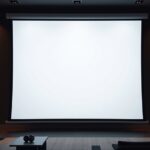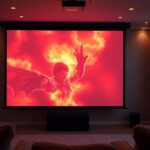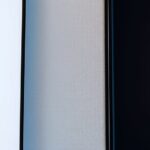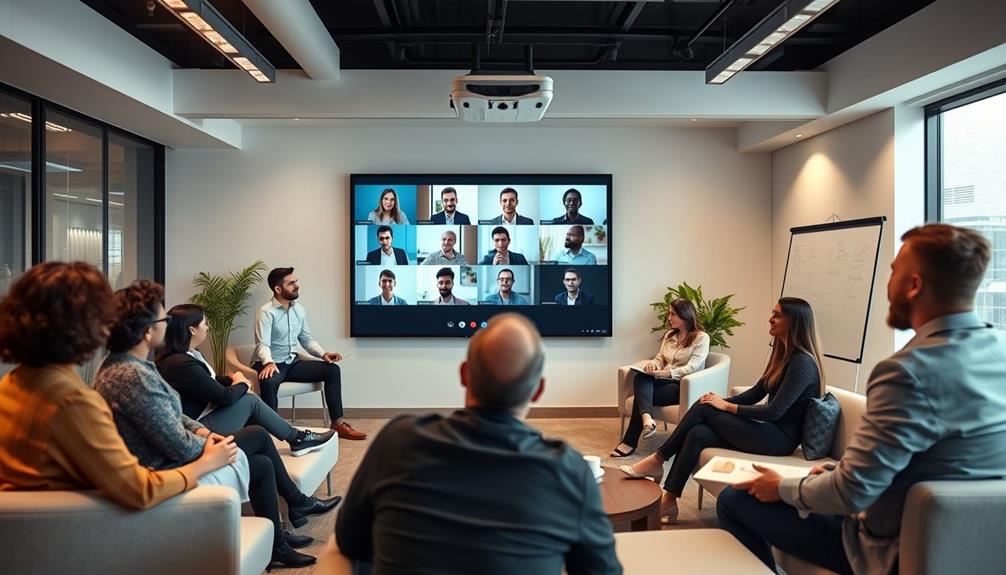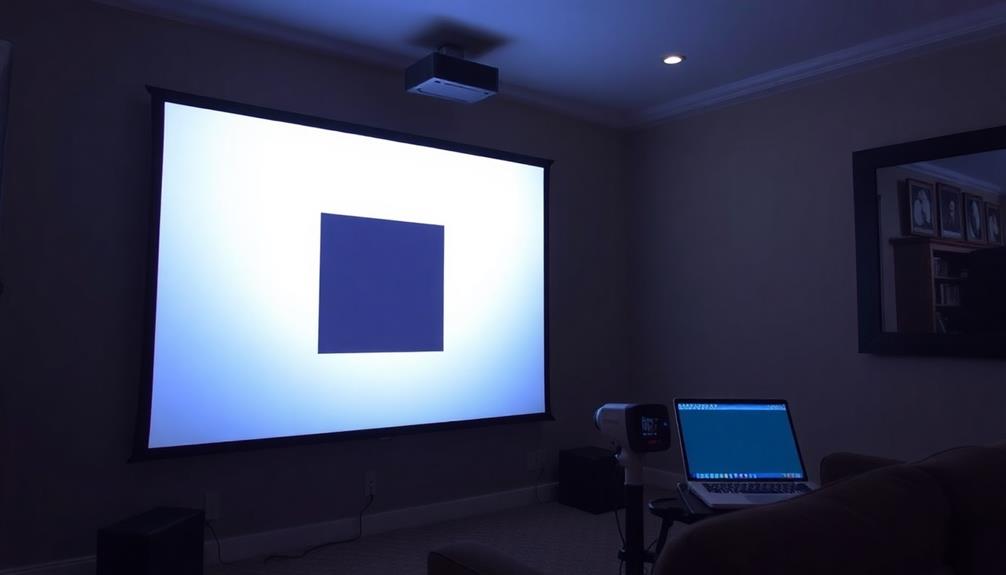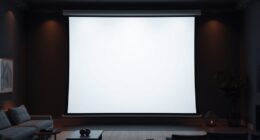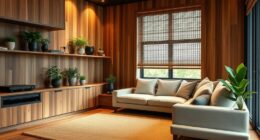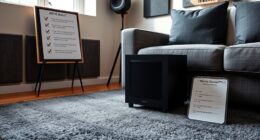When choosing a projector screen material, consider your space and viewing preferences. Fixed frame screens work well in dedicated rooms, while retractable ones keep aesthetics intact in multipurpose areas. If you face bright environments, high gain screens can enhance brightness, but may limit your viewing angles. For versatile setups, standard gain screens maintain consistent quality across different lighting. Don't forget to match the screen material with your projector type and ambient conditions for ideal results. By understanding these factors, you'll set the stage for an impressive viewing experience that fits your needs. Explore further to discover detailed tips!
Key Takeaways
- Choose a screen type based on your space: fixed frame for dedicated rooms, retractable for versatile use, and acoustically transparent for sound integration.
- Consider screen material; high-quality surfaces enhance image clarity, vibrancy, and durability while adapting to environmental conditions.
- Select the appropriate screen size by maintaining a viewing distance of 1.5 times the screen width for optimal immersion.
- Match aspect ratios between the projector and screen (16:9 or 2.35:1) to ensure correct image display and avoid distortion.
- Account for ambient light when choosing screen materials; high contrast gray screens are better for bright environments, while white screens suit controlled lighting.
Understanding Screen Types
When choosing a projector screen, it's essential to understand the different types available to find the best fit for your space.
Fixed frame screens offer a stable projection surface, making them ideal for dedicated media rooms. They provide smooth surfaces at a lower price point compared to other options.
If you're in a non-dedicated space, consider retractable screens, which come in pull-down and pull-up varieties. These allow you to hide the screen when not in use, maintaining room aesthetics.
For bright environments, high gain screens can enhance brightness but may lead to hot-spotting and limited viewing angles.
On the other hand, standard gain screens deliver a balanced experience, accommodating wider seating arrangements.
If you're dealing with well-lit rooms, ambient light rejecting (ALR) screens can markedly improve image vibrancy by rejecting overhead light.
Finally, if audio quality's essential, acoustically transparent screens enable sound to pass through, allowing you to install speakers behind the screen.
Importance of Screen Material
The screen material you choose plays a crucial role in your overall image quality.
It affects not just how vibrant and clear your visuals appear but also how well the material stands up to wear over time.
Plus, selecting the right type can adapt to your specific environment, ensuring you get the best experience no matter the lighting conditions.
Impact on Image Quality
Choosing the right screen material can greatly impact your viewing experience. The quality of the screen surface directly affects image quality, enhancing colors and contrast considerably.
Professional-grade materials outperform standard wall surfaces, providing a flat, wrinkle-free area essential for consistent visuals. If you're dealing with ambient lighting, high contrast screens are your best bet; they improve black levels and depth, preventing the washout that often plagues standard white projection screens.
When selecting a screen, consider the gain value, which indicates how much light the surface reflects. Higher gain screens can boost brightness but may limit viewing angles.
If your setup involves unique requirements, like sound integration, opt for specialized screen materials such as acoustically transparent types. These allow for ideal sound quality while maintaining clear visuals.
Ultimately, the right projection screens can enhance your ideal viewing distance, ensuring that every detail stands out. Investing in quality screen materials is essential for achieving the best image quality, turning your viewing space into a true cinematic experience.
Material Durability Factors
Selecting the right screen material isn't just about image quality; it's also about durability. You want a projector screen that can withstand the wear and tear of regular use. Vinyl screens are a popular choice due to their flexibility and resistance, making them suitable for both home and professional environments.
If you're looking for something more robust, consider high-quality professional-grade materials used in theaters. These materials are designed for longevity, offering a longer lifespan and consistent performance.
When choosing your screen, remember that acoustic transparency is crucial if your setup requires sound to pass through without obstruction. However, the durability of such materials can vary, so choose wisely.
If you often watch in bright conditions, Ambient Light Rejecting (ALR) screens not only improve image quality but also resist light-induced degradation, enhancing their durability.
To maximize the lifespan of your projector screen materials, regular maintenance is key. Dust, moisture, and improper storage can greatly reduce performance and durability.
Environmental Adaptation Needs
Understanding how screen material adapts to your environment is vital for achieving the best viewing experience. The right choice can greatly enhance your image quality based on your space's environmental conditions.
Here's a quick comparison of screen materials based on their performance:
| Screen Material | Ideal Conditions |
|---|---|
| Matte White | Versatile for various projector types; suitable for darkened rooms. |
| High Contrast Gray | Enhances black levels; best for LCD projectors in moderate light. |
| High Gain | Increases brightness in well-lit rooms but may limit viewing angles. |
If you have high ambient light, consider Ambient Light Rejecting (ALR) screens, which boost brightness and contrast. Remember that acoustic transparency is important if you're using hidden speakers, allowing sound to flow seamlessly. Each projector type may require specific screen materials to maximize performance; for instance, DLP projectors shine with high contrast white surfaces. Ultimately, your choice of screen material will depend on brightness, ambient light, and desired viewing angles, so assess your space carefully to make the best decision.
Selecting the Right Size
When selecting the right size for your projector screen, it's essential to take into account your viewing distance for the best experience.
Ideally, you should sit about 1.5 times the screen width away to fully immerse yourself in the content.
Keep in mind that common home theater screens range from 100 to 120 inches, while commercial setups often require even larger options.
Viewing Distance Considerations
Choosing the right viewing distance for your projector screen is vital to achieving an enjoyable viewing experience. The recommended viewing distance is typically about 1.5 times the screen width. For instance, if you have a 100-inch 16:9 screen, sitting about 11 feet away is ideal. This distance helps you enjoy the projected image without straining your eyes.
SMPTE suggests that you sit at a 30° angle to the screen for best immersion. Keep in mind that larger screens, such as a 200-inch setup, require approximately 22 feet of distance for comfortable viewing.
Matching the aspect ratio of your projector and screen is also important; using a 16:9 ratio suits modern content, while a 2.35:1 ratio enhances cinematic experiences.
Additionally, the viewing angle affects the perceived quality of the image. A screen that's too large may cause discomfort, whereas one that's too small mightn't deliver the visual impact you're after.
Screen Size Recommendations
Selecting the right screen size is essential to enhancing your viewing experience. The ideal screen size depends on your room's dimensions, projector throw distance, and the aspect ratio of the content. For home theaters, a commonly recommended screen size ranges from 100 to 120 inches, with the 100-inch screen having a recommended viewing distance of about 11 feet. For larger setups, like a 200-inch screen, you should sit approximately 22 feet away to maintain comfort and image quality.
Here's a quick reference table for screen size recommendations:
| Screen Size | Recommended Viewing Distance |
|---|---|
| 100 inches | 11 feet |
| 120 inches | 12-13 feet |
| 150 inches | 17-18 feet |
| 200 inches | 22 feet |
Using the standard 16:9 aspect ratio is vital to avoid issues like black bars or cropped images, ensuring your projected images look their best. So, when choosing screen types, always consider how the screen size fits with your viewing distance and overall setup for a superior home theater experience.
Aspect Ratio Considerations
Understanding aspect ratios is essential for achieving the best viewing experience with your projector screen. The two most common aspect ratios for projection screens are 16:9 and 2.35:1. The 16:9 ratio is perfect for modern TV shows and presentations, while 2.35:1 is ideal for immersive cinematic experiences.
When your projector's native aspect ratio doesn't match the screen, you might end up with unwanted black bars on the sides or top and bottom, which can diminish image quality. For example, using a 4:3 projector on a 16:9 screen creates unsightly dead space that takes away from the viewing experience.
The Society of Motion Picture and Television Engineers (SMPTE) recommends sitting at a 30-degree angle to the screen, a factor that can also be influenced by the aspect ratio.
If you're interested in anamorphic projection for wider cinematic content, verify your projector and screen are compatible to avoid those annoying black bars while watching 2.35:1 films.
Choosing the right aspect ratio not only enhances the visual experience but also optimizes the overall enjoyment of your content.
Viewing Distance Guidelines
The ideal viewing distance plays a crucial role in maximizing your projector screen experience. To achieve the best immersion, you'll want to position yourself at the right distance based on your screen size. Generally, the recommended viewing distance is 1.5 times the screen width. For instance, if you have a 100-inch screen, sitting about 11 feet away will enhance your viewing experience.
Here's a quick reference table to guide you:
| Screen Size | Recommended Viewing Distance |
|---|---|
| 100 inches | 11 feet |
| 150 inches | 16.5 feet |
| 200 inches | 22 feet |
| 250 inches | 27.5 feet |
| 300 inches | 33 feet |
SMPTE advises a viewing angle of 30 degrees for immersive experiences, while THX recommends a broader 40 degrees. For larger screens, consider adjusting your distance to about 1.2 times the screen size for cinematic experiences or 1.6 times for standard viewing. This way, you can comfortably see details and maintain image clarity without straining your eyes, ensuring a more enjoyable cinematic experience.
Environmental Factors
When setting up your projector, it's important to reflect on how environmental factors can impact your viewing experience. Ambient light conditions play a significant role in your choice of screen materials. In bright environments, high contrast gray screens are preferred, as they help mitigate light washout and improve contrast.
On the other hand, white screens shine in controlled lighting settings, offering excellent brightness.
You'll also want to take into account the viewing angle. Higher gain screens can produce dimmer images when viewed off-center, which might affect how everyone enjoys the presentation.
Room characteristics, such as wall color and furniture placement, can reflect and absorb light, further impacting image quality. For instance, darker walls may enhance contrast but can also absorb too much light.
Selecting the right screen material for your space is vital for achieving ideal brightness and contrast. By understanding these environmental factors, you can enhance your overall viewing experience.
Make sure to assess the lighting and characteristics of your room before deciding, ensuring you create the best possible setup for your projector.
Matching Projector and Screen
To achieve the best viewing experience, matching your projector with the right screen is fundamental. Start by confirming both share the same aspect ratio, like 16:9 or 2.35:1, to prevent cropping or distortion of the image.
Different projectors, whether long-throw, short-throw, or ultra-short throw (UST), require specific screen materials to optimize performance and image quality.
Consider the brightness and resolution of your projector when selecting screen materials. For instance, if you have a high-lumen projector, it's best to pair it with an ambient light rejecting (ALR) screen in well-lit environments.
Proper calibration of the projector in relation to the screen surfaces is imperative, as this enhances image quality and guarantees accurate color and contrast representation.
Lastly, understand the projector specifications, including gain values and recommended viewing distance. This knowledge is essential for achieving a high-quality viewing experience.
Frequently Asked Questions
How Do I Choose a Projector Screen Material?
To choose a projector screen material, consider your room's lighting, screen gain, and your projector type. Think about how bright you want the image and whether you need better contrast for a clearer picture.
What Is the Best Display Type for a Projector?
You can't just slap any old screen up and expect magic! The best display type for your projector's a matte white screen. It balances lighting beautifully, making every image pop, no matter the conditions.
Does the Screen Type Matter for a Projector?
Yes, the screen type definitely matters for your projector. It affects image quality, brightness, and viewing angles. Choosing the right material can enhance your overall viewing experience, making your content more vibrant and enjoyable.
What Is the Best Format for a Projector Screen?
Choosing the best format for a projector screen's like finding the holy grail of viewing experiences! You'll want to take into account your space, purpose, and projector type to guarantee stunning visuals that leave everyone in awe.
Conclusion
In the grand tapestry of home entertainment, choosing the right projector screen material can feel like selecting the perfect fabric for a royal gown! By understanding screen types, sizes, and environmental factors, you'll elevate your viewing experience to cinematic heights. Don't just throw any screen on your wall; it's like putting a paper crown on a king! So, dive deep into the details, and transform your space into a blockbuster-worthy haven that'll leave everyone in awe!



